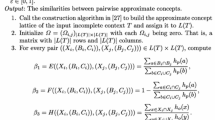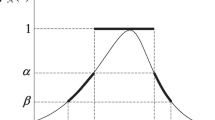Abstract
With the expansion of database, the complexity of concept lattices grows rapidly. Therefore, the compression of formal concepts becomes particularly important. To solve this problem, we present neighborhood based concept lattice. Firstly, two pairs of approximation operators are presented to construct 1-neighborhood object-induced concept lattice and 1-neighborhood attribute-induced concept lattice. Then, the pseudo similarity between objects and the pseudo similarity between attributes are introduced. 1-neighborhood object-induced concept lattice based on coverings and 1-neighborhood attribute-induced concept lattice based on coverings are proposed based on pseudo similarities. The neighborhoods are adjusted by the pseudo similarity, and the number of the neighborhood based concepts can be compressed. Besides, the relationship between neighborhood based concept lattice and Wille’s concept lattice is discussed. We prove that the intents of 1-neighborhood object-induced concepts based on minimal (resp. maximal) intersection neighborhood are the intents of Wille’s formal concepts. Meanwhile, the extents of 1-neighborhood attribute-induced concepts based on minimal (resp. maximal) intersection neighborhood are the extents of Wille’s formal concepts. In addition, the multi-neighborhood concept lattice is presented, the relationship between 1-neighborhood concept lattice and multi-neighborhood concept lattice is discussed. Finally, the experimental results show that the compressing of neighborhood based concept lattice is more effective when parameter values are smaller.







Similar content being viewed by others
References
Wille R (1982) Restrueturing lattice theory: an approach based on hierarchies of concepts. In: Rival I (ed) Ordered Sets. Reidel, Dordrecht-Boston, pp 445–470
Gediga G, Duntsch I (2002) Modal-style operators in qualitative data analysis. In: Proceedings of the 2002 IEEE International conference on data mining, Maebashi City, Dec 9-12, 2002 Piscataway: IEEE, pp 155–162
Yao Y (2004) Concept lattices in rough set theory. In: Proceedings of the IEEE annual meeting of the fuzzy information, Banff, Jun 27-30, 2004, vol 2004. IEEE, Piscataway, pp 796–801
Yao Y (2004) A comparative study of formal concept analysis and rough set theory in data analysis. In: Proceedings of the 4th International conference on rough sets and current trends in computing, Uppsala, Jun 1-5, vol 2004. Springer, Berlin, pp 59–68
Burusco A, Fuentes González R. (1994) The study of the L-fuzzy concept lattice. Mathware Soft Comput 1(3):209–218
Li Y, Liu Z, Shen X, et al. (2003) Theoretical research on the distributed construction of concept lattices. In: International conference on machine learning & cybernetics. IEEE, pp 474–479
Valtchev P, Missaoui R, Lebrun P (2002) a partition-based approach towards constructing galois (concept) lattices. Discret Math 256(3):801–829
Yang S, Lu Y, Jia X, Li W (2020) Constructing three-way concept lattice based on the composite of classical lattices. Int J Approx Reas 121:174–186
Zhang W, Wei L, Qi J (2005) Attribute reduction in concept lattice based on discernibility matrix. Lect Notes Comput Sci 3642:157–165
Zhang W, Wei L, Qi J (2005) Attribute reduction theory and approach to concept lattice. Sci Chin (Series F: Inform Sci) 48(6):713–726
Li J, Aswani Kumar C, Mei C et al (2017) Comparison of reduction in formal decision contexts. Int J Approx Reason 80:100–122
Shao M, Yang H, Wu W (2015) Knowledge reduction in formal fuzzy contexts. Knowl-Based Syst 73:265–275
Shao M, Leung Y, Wang X, et al. (2016) Granular reducts of formal fuzzy contexts. Knowl-Based Syst 114:156–166
Wei L, Qi J, Zhang W (2008) Attribute reduction theory of concept lattice based on decision formal contexts. Sci Chin (Series F: Inf Sci) 51(7):910–923
Wu W, Leung Y, Mi J (2009) Granular computing and knowledge reduction in formal contexts. IEEE Trans Knowl Data Eng 21(10):1461–1474
Li J, Mei C, Lv Y (2012) Knowledge reduction in real decision formal contexts. Inform Sci 189:191–207
Mi J, Leung Y, Wu W (2010) Approaches to attribute reduction in concept lattices induced by axialities. Knowl-Based Syst 23(6):504–511
Qin K, Li B, Pei Z (2019) Attribute reduction and rule acquisition of formal decision context based on object (property) oriented concept lattices. Int J Mach Learn Cybern 10:2837–2850
Ganter B, Stumme G, Wille R (2005) Formal concept analysis: foundations and applications. Springer-Verlag
Li J, Mei C, Lv Y (2013) Incomplete decision contexts: approximate concept construction, rule acquisition and knowledge reduction. Int J Approx Reas 54(1):149–165
Yoshiyuki, Matsumoto, Junzo et al (2018) Knowledge acquisition from rough sets using merged decision rules. J Adv Comput Intell Intell Inform 22(3):404–410
Belohlavek R (2000) Similarity relations in concept lattices. J Log Comput 10(6):823–845
Kent R (1996) Rough concept analysis: a synthesis of rough sets and formal concept analysis. Fundamenta Informaticae 27(2):169–181
Yao Y (2004) A comparative study of formal concept analysis and rough set theory in data analysis. International conference on rough sets & current trends in computing
Qi J, Wei L, Li Z (2005) A partitional view of concept lattice. Lect Notes Comput Sci 3641:74–83
Saquer T, Deogun J (2001) Concept approximations based on rough sets and similarity measures. Comput Sci 11:655–674
Zhang W, Yao Y, Leung Y. (2006) Rough set and concept lattice. Jiaotong University Press Xian
Shao M, Guo L, Wang C (2018) Connections between two-universe rough sets and formal concepts. Int J Mach Learn Cybern 4:1–9
Yao Y (2016) Rough-set concept analysis: interpreting RS-definable concepts based on ideas from formal concept analysis. Inform Sci 346:442–462
Pawlak Z (1982) Rough sets. Int J Comput Inform Sci 11:341–356
Yang B, Hu B (2019) Fuzzy neighborhood operators and derived fuzzy coverings. Fuzzy Set Syst 370:1–33
Zhang X, Wang J (2020) Fuzzy β-covering approximation spaces. Int J Approx Reason 126:27–47
Chen N, Ge X (2015) The covering method for attribute reductions of concept lattices. J Comput Anal Applic 19(1):100–110
Shao M, Wu W, Wang X, Wang C (2020) Knowledge reduction methods of covering approximate spaces based on concept lattice. Knowl-Based Syst, 191
Ye J, Zhan J, Ding W, Fujita H (2021) A novel fuzzy rough set model with fuzzy neighborhood operators. Inform Sci 544:266–297
Yang X, Li T, Liu D, Fujita H (2020) A multilevel neighborhood sequential decision approach of three-way granular computing. Inform Sci 538:119–141
Yue X, Chen Y, Miao D, Fujita H (2020) Fuzzy neighborhood covering for three-way classification. Inform Sci 507:795–808
Wei L, Li Q (2012) Covering-based reduction of property-oriented concept lattices. J UESTC 41(02):299–304
Ma L, Mi J, Xie B (2017) Multi-scaled concept lattices based on neighborhood systems. Int J Mach Learn Cybern 8(1):149–157
Yao Y (2006) Neighborhood systems and approximate retrieval. Inform Sci 176(23):3431–3452
Day M (1944) Convergence, closure and neighborhoods. Duke Math J 11:181–199
Zhu W (2009) Relationship between generalized rough sets based on binary relation and covering. Inform Sci 179(3):210–225
Mordeson J (2001) Fuzzy mathematics. Springer
Acknowledgments
This work has been partially supported by the National Natural Science Foundation of China (Grant No. 61976130). This work has been partially supported by the China Scholarship Council (Grant No. 202107000028)
Author information
Authors and Affiliations
Corresponding author
Additional information
Publisher’s note
Springer Nature remains neutral with regard to jurisdictional claims in published maps and institutional affiliations.
Rights and permissions
About this article
Cite this article
Yang, H., Qin, K., Hu, Q. et al. Neighborhood based concept lattice. Appl Intell 53, 6025–6040 (2023). https://doi.org/10.1007/s10489-022-03828-2
Accepted:
Published:
Issue Date:
DOI: https://doi.org/10.1007/s10489-022-03828-2




